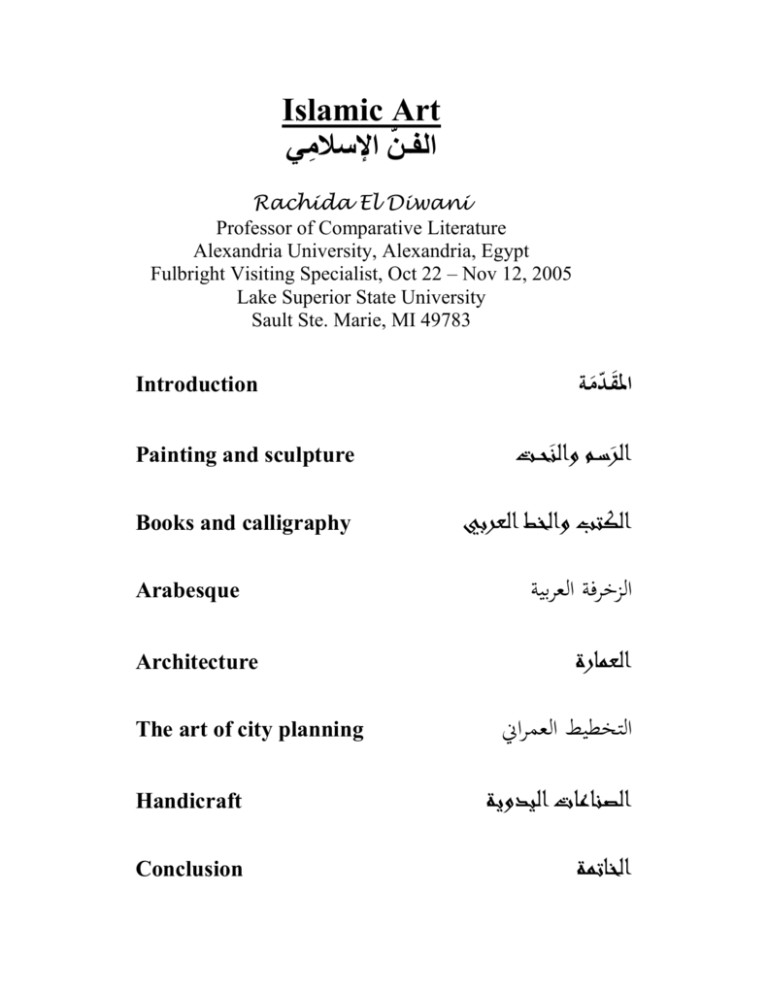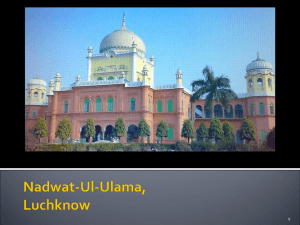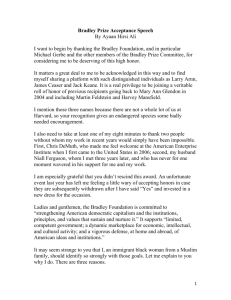Arts in Islam - Lake Superior State University
advertisement

Islamic Art ّ اإلسالمي الفـن ِ Rachida El Diwani Professor of Comparative Literature Alexandria University, Alexandria, Egypt Fulbright Visiting Specialist, Oct 22 – Nov 12, 2005 Lake Superior State University Sault Ste. Marie, MI 49783 Introduction امل َقـ ّد َمـة Painting and sculpture الرس ـم والنَح ـت َ Books and calligraphy الكتب والخط العربي Arabesque Architecture The art of city planning الزخرفة العربية العمارة التخطيط العمراين Handicraft الصناعات اليدوية Conclusion الخاتمة Islamic Art Rachida El Diwani Professor of Comparative Literature Alexandria University, Alexandria, Egypt Fulbright Visiting Specialists, Oct 22 – Nov 12, 2005 Lake Superior State University Sault Ste. Marie, MI 49783 I. Introduction Islamic art initially brought together trends and styles borrowed from all the cultures and civilizations that the Arabs encountered in their way. They borrowed from Byzantine, Hellenistic, Nabatean and Coptic artistic traditions. They also encountered Berbers, Slavs, Turks, Goths and various African peoples, among others. The Muslims chose from these diverse local practices what suited their beliefs and tastes. Soon Islamic artists developed the borrowed traits. They created their own motifs, styles and trends in conformity with the special vision of their religion. They integrated the regional varieties within the larger framework of Islamic civilization, which springs from Islam as a faith and a way of living. These different cultures, synthesized in the Muslim consciousness, left their mark on Islamic art and created its most distinguished and distinguishing trait: “unity within diversity” or “diversity within unity” they shaped their own aesthetics which gives a very special characteristic to the Islamic art. Islamic art include any artistic manifestation created by a Muslim or non Muslim artist that adheres to Islamic aesthetics, principles and concepts. This artistic manifestation being created for the spiritual, intellectual, and physical usage and pleasure of Muslims or non-Muslims living within the sphere of Islamic thought and civilization. While Islamic art is quite broad in its definition and includes all the art forms known in other civilizations, there are very specifically Islamic issues at work in every area. 2 II. Painting and sculpture No Islamic discussion on Islamic art can ignore figurative painting and aniconism (opposition to the use of icons or visual images to depict living creatures or religious figures). Two sayings attributed to the Prophet of Islam set the law for aniconism and directed the painting away from the naturalistic figurative tradition. These sayings are : “on the day of judgment artists will be asked to give life to their own artistic works, and when they fail to do so, they will be severely punished”, and the other saying is: “ those who will be most strictly punished by God on the Day of judgment will be the painters and sculptors”. Other sayings explain that the idea was to combat idolatry and pride expressed by the act of imitating living beings created by God. Artistic creativity not aiming to emulate God in his creation was not condemned by these sayings. Islam was not forbidding the artistic creativity as such, but was safeguarding the absolute monotheism so central to the new message. Artistic creativity effectively found other ways to fulfill and manifest itself. In Islam, aniconism means above all the prohibition of the portraiture of the Divine, or any plastic representation of God who is beyond any possible description or representation. Pictorial art in Islam adhered to the concept of representing spiritual beauty, rather than simply banning natural representation and depicted personages, nature and objects through stylization and abstraction, in order to portray them as prototypes or ideal models. Stylization and abstraction show a kind of rejection of the material world. Because of this rejection, the Muslim artist did not try to represent the Prophet in concrete terms, even though his physical attributes were accurately described in early manuscripts. For the Muslims, the Prophet Muhammad is the embodiment of the ideal man not to be presented through temporal and physical properties. We can see the development of the image of the Prophet Muhammad well illustrated in the Turkish and Iranian traditions where in the early years of conversion to Islam, his face was shown as in a portrait. In later years, when the spirit of the religion was fully comprehended, he is represented symbolically, with his face covered; finally, in the Ottoman Hilya-I sharif of the eighteenth century, he is represented linguistically in a calligraphic portrait that enumerates both his physical and spiritual qualities, embellished with illumination. 3 Painting in Islam does not convey a religious message. In the Islamic tradition, the Arabic language is sufficient for spiritual and physical expression and fully replaces imagery with its illustrative vocabulary. In the early stages of non- Arabs’ conversion to Islam, images filled a pedagogical need, which can be seen in the miniature painting of religious subject that flourished among the Mongols, Turks, and Iranians. Some Muslims limited the prohibition concerning the representation of living creatures to those paintings and sculptures made for worshipping purposes and allowed it for the purpose of decoration. It has to be said that this was not the opinion of the religious experts on the matter. But every body agreed not to allow any of these representations in the worshipping places. Islamic figurative artists gained some legitimacy among Arabs, Mongols, Iranians, Indians and Turks by avoiding naturalism, particularly the use of threedimensional perspective and modeling the human figure in light and shade. Through stylization of forms pertaining to living beings, the Islamic artist was able to fulfill his creative instincts and adhere to his religious beliefs. Muslims, by opposition to other cultures and peoples who have taken humankind as the “mesure of all things” and nature as the ultimate determiner, have focused on the transcendence of God. The Islamic arts have the same objective as the Quran: to enlighten men and strengthen their comprehension of Divine transcendence. Accordingly Islamic aesthetics seek to represent the spiritual and intangible qualities of a subject, to free art from the confines of its period and to render it timeless by leaving aside natural imitation. III. Books and calligraphy The arts of the book, including calligraphy, illumination, miniature painting, marbling, bookbinding and paper-making were the most distinguished forms of arts in the Islamic civilization. Calligraphy is entirely Islamic. The religion being its raison d’être, is considered the purest of all Islamic arts. It has grown from the spirit of Islam, embodied in the Quran and the dignified status writing occupies in the religion. It preserves the word of God, perpetuates and presents it in its best form. Calligraphy had pervaded all aspects of Islamic art: architecture, weaving, textiles, household utensils and artifacts, arms, banners, jewelry, coins, books, and all kinds of tools. Islamic artists wrote on all imaginable kind of surface including 4 stone, vellum, leather, fabric, glass, wood, paper, gems, metal, plaster, brick, ivory and clay. IV. Arabesque Arabesque is the epitome of Islamic art. It consists primarily of a number of two dimensional regular shapes that can be indefinitely repeated at regular intervals. The shapes consist of vegetal forms borrowed from nature like tree leaves, flowers, vines or geometric forms based on the circle, square and triangle. Arabesque was the decoration for any empty space and was used to fill it in a continuous, repetitive manner with great aesthetic value, as well as a spiritual connotation signifying the infinity of God. V. Architecture Architecture is one of the most important art forms in Islam, embodying the strictness, simplicity and purity of its edicts. It serves also as a catalyst for a number of other art forms such as ceramics, glass, calligraphy, painting and sculpture. Artists, artisans, workmen and architects collaborated in constructing and decorating buildings whose design and ornamentation intermingled in a spontaneous order to unite within a complete oneness. VI. The art of city planning Muslims perfected this art. They studied their space within the city and designed the places for the buildings fulfilling their community’s spiritual, physical and aesthetic needs. The Islamic city is built around the mosque. There, in the house of God, members of the Umma, the Muslim community, congregate for prayers, discussions, political meetings and education. Surrounding it are the palace, the treasury, the madrassa (college or school of Islamic sciences), the takiyah or khanqah (sufi derwich lodge), the khan (caravanserai or rest- house), the suq (market area), the maristan or bimaristan (hospital), and the cemetery. All these places were answering the people’s metaphysical, spiritual and material needs, from the cradle to the grave. Because of the importance of the mosque in the life of the Muslim society, special care was given to its architecture, decoration and structure. 5 VII. Handicraft Art is not to be separated from handicraft in Islamic art, where artisan and artist are one because each article produced requires artistic creativity as well as professional skill. Artistry and skill are fundamental in the production of all configurations of Islamic art, from the religious (such as the copying and illumination of the Quran) to the making of ceramics, glass, metal, utensils, ivories, jewelry, the minting of coins, the weaving of textiles, and the producing of musical instruments. VIII. Conclusion We have said that in the seventh century, when the Arabs came in contact with other civilizations, they learned various skills and borrowed styles and forms from many sources, they combined them afterward to suit their own taste. Islamic culture was soon able to shed its forein influence and develop its own styles and trends, based on its own aesthetic and religious values. The Islamic artist’s rejection of the temporal world made him supersede its three- dimensional tangible boundaries. Its aversion to imitate nature, wether in its ideal or realistic forms, gave Islamic art a timeless quality that helped it endure to this day. References Wijdam Ali, the Arab contribution to Islamic art. Cairo, the American University Press, 1999. 6









